| Hermosa–Duhat–Balintawak Transmission Line | |
|---|---|
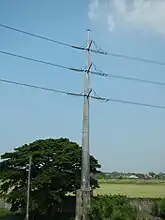 Steel pole 227 (of anchor or flag design) located near San Simon Exit of North Luzon Expressway (NLEX). | |
| Location | |
| Country | Philippines |
| Province | Bataan Pampanga Bulacan Metro Manila |
| Coordinates | 14°51′57″N 120°29′38″E / 14.86583°N 120.49389°E 14°47′14″N 120°57′10″E / 14.78722°N 120.95278°E 14°39′38″N 121°0′44″E / 14.66056°N 121.01222°E |
| From | Hermosa Substation |
| Passes through | Meralco Duhat Substation |
| To | Balintawak Substation |
| Ownership information | |
| Owner | see Ownership, operations, and maintenance information |
| Operator | see Ownership, operations, and maintenance information |
| Construction information | |
| Contractors | Herrera Engineering Corporation (HEC) |
| Construction started | September 1993 |
| Commissioned | June 1994 |
| Technical information | |
| Type | Overhead transmission line |
| Type of current | HVAC |
| Total length | 87.54 km (54.39 mi) |
| No. of transmission towers | 506 (483 steel poles, 13 lattice towers, 9 portal towers, and 1 concrete pole) |
| AC voltage | 230 kV |
| No. of poles | 484 (483 steel poles and 1 concrete pole) |
| No. of circuits | 1 |
The Hermosa–Duhat–Balintawak Transmission Line (abbreviated as HB, RHB,[lower-alpha 1] 8LI1DUH-HER,[lower-alpha 2] and 8LI1QUE-DUH[lower-alpha 3]), also known as Hermosa–Marilao–Quezon Transmission Line, Hermosa–Duhat Transmission Line, and Duhat–Balintawak Transmission Line, is a 230,000 volt, single-circuit, two-part transmission line in Metro Manila and Central Luzon, Philippines that connects Hermosa and Balintawak substations of National Grid Corporation of the Philippines (NGCP), with line segment termination at Manila Electric Company (Meralco) Duhat substation in Duhat, Bocaue, Bulacan.
History
The Hermosa–Duhat–Balintawak Transmission Line began construction in September 1993 and went into service in June 1994.[1][2] It is the first transmission line in the Philippines to use the expressway right-of-way or alignment before the other transmission lines such as the Sucat–Paco–Araneta–Balintawak, Bay–Biñan, and Dasmariñas–Las Piñas lines which run along Metro Manila Skyway, South Luzon Expressway (SLEX), and Manila–Cavite Expressway (CAVITEX), respectively.
NAPOCOR relocated its Santa Barbara Bridge–Villa del Sol segment through the Lahar-Affected Transmission Line Relocation project, using 30 replacement steel poles. It was completed in April 2003 when TransCo is now the operator and owner of the transmission line.[3]
In 2007, 3 steel poles were relocated due to the construction of Dulalia Overpass using 2 existing steel poles (473 and 475) and 1 replacement steel pole (474). NAPOCOR-era steel pole 474 which is a suspension tower and has triangle tower design, however, was later used as one of the poles of a bipole tower of Mexico–Hermosa Transmission Line.
The cut-in connection to Meralco Duhat substation was constructed to avoid line overloading and maintain N-1 criterion. It was completed on November 16, 2009.
In 2010, 3 replacement and higher steel poles (381–383) were used due to the construction of Balagtas Interchange, with NAPOCOR-era steel poles 381 and 382 which are both anchor towers and have flag tower design were reused as part of Hermosa–San Jose line while pole 383 (of suspension tower or flag design) was retired. Also later on that said year, the relocation of San Fernando segment of the line was started with the retiring of pole 167 and replacing with NAPOCOR-era steel pole 275 that was originally located along MacArthur Highway in Calumpit, Bulacan to alleviate heavy traffic along Jose Abad Santos Avenue due to the presence of its electric poles standing on the highway itself, and to pave the way for the expansion of some segments of the avenue, particularly at Barangay Dolores.[4][5]
The Hermosa–Balintawak Transmission Line Relocation project involved the relocation of its San Simon–Pulilan segment along NLEX using 58 steel poles (43 replacement and 15 existing poles) and 4 lattice towers (2 replacement and 2 existing towers). The project started on February 18, 2008 when TransCo operated and maintained the power line. It was completed on March 25, 2011 when NGCP is now the operator of the line.[6][7][8]
On June 2011, three months after the completion and energization of the relocated San Simon–Pulilan section of the transmission line, removal of 84 NAPOCOR-era steel poles (228–263, 266–313) and 2 lattice towers (264 and 265) as well as the retirement of 70 out of 84 steel poles (230, 232–258, 262, 263, 268–270, 272–274, 277–282, 284–300, 303–313) that were located along MacArthur Highway from San Simon, Pampanga to Caltex in Calumpit, Bulacan and Pulilan Regional Road from Calumpit to Pulilan Exit in Pulilan was completed. Some poles were later used as bipole towers of Mexico–Hermosa and Hermosa–Limay transmission lines while other were used on various NGCP substations (i.e. Laoag Substation).
Throughout its existence, several steel poles and lattice towers were painted with aluminum paint to protect them from corrosion and extend their service lifespan, with painting of steel poles with aluminum were made from 2015 to 2021.
Route description
The Hermosa–Duhat–Balintawak Transmission Line passes through the cities of Quezon City, Caloocan, and Valenzuela in Metro Manila, Meycauayan and Malolos in Bulacan, and San Fernando in Pampanga and municipalities of Marilao, Bocaue, Balagtas, Guiguinto, Plaridel, Pulilan, and Calumpit in Bulacan, Apalit, San Simon, Santo Tomas, Bacolor, Guagua, and Lubao in Pampanga, and Hermosa in Bataan. It is located within the service area of NGCP's North Luzon Operations and Maintenance (NLOM) Districts 5 (West Central Plain), 6 (South Central Plain), and 7 (National Capital Region).[9]
Hermosa–Duhat

Hermosa to San Fernando
The transmission line starts at Hermosa Substation and run parallel with Jose Abad Santos Avenue until NLEX's San Fernando Exit. It enters Pampanga upon passing the Bataan–Pampanga welcome arch and continues straightforward. While running parallel with the said avenue, it intersects with Hermosa–Guagua in Lubao, Mexico–Hermosa in Lubao, Guagua, Bacolor and San Fernando, and Hermosa–Malolos–San Jose lines in Guagua. It then utilize the eastern side of the avenue upon approaching Santa Barbara Bridge.
It passes through the lahar-filled Bacolor and enters San Fernando upon passing the city's welcome arch. The line again utilizes the western side of the avenue after Villa del Sol in Magliman, San Fernando. It crosses into Lazatin Boulevard upon passing Lazatin Flyover and passes through residential areas and establishments located within San Fernando. The power line then crosses into MacArthur Highway upon passing Dolores Flyover and continues on a straight direction until San Fernando Exit.
San Fernando to Bocaue
The line enters the western side of NLEX via San Fernando Exit and runs parallel into it until Harbor Link Interchange. After entering NLEX, it intersects with Mexico–Hermosa line for a fifth and final time. It continues on a straight route, intersecting with Mexico–Balintawak and Mexico–Calumpit lines in Santo Tomas, and passes through San Simon Exit (where the line left the NLEX alignment prior to the relocation of its San Simon–Pulilan section in 2011).[lower-alpha 4] The line continues on a straight alignment and runs parallel with Candaba Viaduct where it crosses Pampanga River and Apalit Bypass Road, and passes through rice paddies and swampland in Apalit, Calumpit, and Pulilan. It then enters Bulacan after passing the former location of a billboard located near steel pole 271 (8LI1DUH-HER)138).
It intersects with the Hermosa–San Jose 500,000 volt transmission line a few meters after exiting Pampanga and entering Bulacan, with a lattice tower of the said power line is located near steel pole 273 (8LI1DUH-HER)136). The power line then passes into Pulilan Exit (where it reentered the NLEX alignment from 1994 to 2011), continues straightforward, intersects with Hermosa–Malolos–San Jose in Plaridel and Mexico–Balintawak lines in Guiguinto for the second time, passes into Balagtas Interchange, Bigaa and Santa Maria Rivers, Bocaue Exit, Bocaue Toll Plaza, and Ciudad de Victoria Interchange. It turns left into Meralco Duhat Substation a few meters after passing Ciudad de Victoria interchange, where the line's Hermosa–Duhat section ends.
Duhat–Balintawak
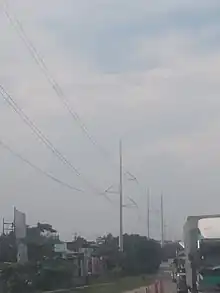
Bocaue to Quezon City
The line turns left upon entering NLEX, continues on a straight direction, and enters Metro Manila after steel pole 465 (8LI1QUE-DUH)051). It then utilizes the eastern side of NLEX after steel pole 488 (8LI1QUE-DUH)032) and leaves the expressway at Harbor Link Interchange. After leaving NLEX, it passes through residential areas, establishments, and institutions located within Caloocan and Quezon City, crosses into Quirino Highway, and enters Balintawak Substation.
Inside Balintawak Substation is the transmission line's last steel pole and structure which is pole 515 (8LI1QUE-DUH)001) and after it, the line connects to San Jose del Monte–Balintawak Transmission Line line 3 through its steel pole 1 (8LI3SJO-QUE)001) where the lower insulators belong to the said power line while the upper additional asymmetrical insulators are used to support the Hermosa–Duhat–Balintawak line itself before the latter ends at a portal tower of a substation mentioned before.
Technical description
The transmission line is a single-circuit, double-bundle power line and the contractor for its construction is Herrera Engineering Corporation (HEC).
Steel poles can have flag (suspension and anchor variants) and triangle tower designs. From 1994 to 2019, steel pole 424 originally had triangle tower design before being changed to asymmetrical due to the construction of Ciudad de Victoria interchange. Cement pole that is used on the line's intersection with Hermosa–Guagua 69kV line and steel pole 516 located inside Balintawak Substation also have an asymmetrical tower design. Lattice towers, however, have incomplete tower design. Portal towers are used on portions of the line where it intersects with another power line. Each steel poles, lattice towers, and portal towers have three insulators.
| Segment | Current | Volts | Heading |
|---|---|---|---|
| Hermosa–Duhat (other segments) | not measured | 230,000 | North/South |
| Duhat–Balintawak | |||
| Relocated Guagua–San Fernando | |||
| Relocated San Fernando | |||
| Relocated San Simon–Pulilan | |||
| Balagtas | |||
| Bundle type and segment | Spacers | Amps | Broken spacers |
|---|---|---|---|
| double bundle (Hermosa–Duhat; other segments) | 500 + | not measured | 100 + |
| double bundle (Duhat–Balintawak) | 300 + | not measured | 30 + |
| double bundle (Relocated Guagua–San Fernando) | 300 + | not measured | 0 |
| double bundle (Relocated San Fernando) | 300 + | not measured | 0 |
| double bundle (Relocated San Simon–Pulilan) | 300 + | not measured | 0 |
| double bundle (Balagtas; higher steel poles and newer pedestal over existing structure due to the construction of Balagtas Interchange) | 35 | not measured | 0 |
| Segment | Number of structures | Length |
|---|---|---|
| Hermosa–Duhat (other segments) | 301 (288 steel poles, 9 portal towers, 3 lattice towers, 1 cement pole) | 50.42 km |
| Duhat–Balintawak | 94 (88 steel poles and 6 lattice towers) + connection to San Jose del Monte–Balintawak Transmission Line line 3 through its steel pole 1 between pole 515 of Hermosa–Duhat–Balintawak line itself and a portal tower inside Balintawak Substation where the latter ends | 15.94 km |
| Relocated Guagua–San Fernando segment | 30 steel poles (RHB 1-30) | 5.55 km |
| Relocated San Fernando segment | 11 steel poles | 3.04 km |
| Relocated San Simon–Pulilan segment | 62 (58 steel poles (228–254, 257–265, 268–289), 4 lattice towers (255, 256, 266, 267) (45 replacement, 17 second-hand structures) |
11.41 km |
| Balagtas segment (higher steel poles and newer pedestal over existing structure due to the construction of Balagtas Interchange) | 4 steel poles (381–384) (3 replacement, 1 existing) |
565.07 m |
| Province | Number of structures |
|---|---|
| Bataan | 4 (4 steel poles (1–4)) |
| Pampanga | 271 (257 steel poles (5–55, 58–98, 100–125, RHB-01–RHB-30, 159–254, 257–265, 268–271), 7 lattice towers (56, 57, 99, 255, 256, 266, and 267), 6 portal towers, and 1 concrete pole (58A) |
| Bulacan | 181 (178 steel poles (272–289, 314–429, 8 steel poles used on the transmission line's cut-in connection to Duhat Substation, 430–465) and 3 portal towers) |
| Metro Manila | 50 (44 steel poles (466–496, 500–511, 515) and 6 lattice towers (497–499, 512–514)) + 1 steel pole belonging to San Jose del Monte–Balintawak Transmission Line line 3 (8LI3SJO-QUE)001) located between pole 515 and a portal tower inside Balintawak Substation served as connection of Hermosa–Duhat–Balintawak to the former as the two lines intersect and cross with each other |
| Date | Transmission line details |
|---|---|
| June 1994–October 1995 | Power line originally had 504 steel poles (1–55, 58–98, 100–263, 266–496, 500–511, and 515), 11 lattice towers (56, 57, 99, 264, 265, 497–499, and 512–514), and 12 portal towers totaling to 527 structures. |
| June 1994–November 16, 2009 | Direct tap connection, one part power line, and had a length of 91 km (57 mi). |
| October 1995–April 2003 | Reduced steel pole count to 503 as pole 143 washed away by lahars from Mount Pinatubo and was replaced with a h-frame wood pole. |
| April 2003–November 16, 2009 | Reduced steel pole count to 500 and portal towers to 9 due to Lahar-Affected Relocation Project. This retired the 31 steel poles (126, 129–157) and 3 portal towers located at the western side of Jose Abad Santos Avenue, with two poles (127 and 158) were later used on a cut-in connection to Meralco Duhat substation in Duhat, Bocaue, Bulacan and as pole 5A of Mexico–Hermosa Transmission Line which replaced a h-frame wood pole, respectively. |
| November 16, 2009–present | Upon the completion of a cut-in connection to Meralco Duhat substation, the line is now a two-part transmission line thus it is referred to as Hermosa–Duhat from Hermosa Substation to Duhat Substation and Duhat–Balintawak from Duhat Substation to Balintawak Substation. |
| November 16, 2009–March 2011 | Extended to 91.59 km (56.91 mi) upon the completion of its cut-in connection to Meralco Duhat substation. |
| March 2011–present | Reduced to its current length of 87.54 km (54.39 mi) when its San Simon–Pulilan segment was relocated along North Luzon Expressway (NLEX). |
Ownership, operations, and maintenance information
The transmission line was originally operated, maintained, and owned by the government-owned National Power Corporation (NAPOCOR/NPC) from June 1994 to March 1, 2003. Operations, maintenance, and ownership of the line then transferred to another government corporation National Transmission Corporation (TransCo) on March 1, 2003 where it operated and maintained the line until January 15, 2009. The line's operations and maintenance was transferred to privately-owned National Grid Corporation of the Philippines (NGCP) on January 15, 2009 where it now operates and maintains the power line since then.
As a result of the turnover from TransCo to NGCP, and Republic Act (RA) 9511 and concession agreement between both parties which authorized the latter to exercise the right of eminent domain necessary for the construction, expansion, and efficient maintenance and operation of the transmission system and grid and the efficient operation and maintenance of the subtransmission systems which have not yet been disposed by TransCo where NGCP acts as the temporary owner of these assets and facilities and they will be transferred to TransCo once the 50-year NGCP concession period ends on December 1, 2058, lands where the transmission structures stand and their pedestals or foundations and right-of-way or portions of a power line acquired and designated, and facilities built or placed whether using secondhand (NAPOCOR/NPC and TransCo-era) with a new function or entirely new structures from January 15, 2009 (steel poles 228–254, 257–265, 268–289, 381–384, and steel pole 1 of San Jose del Monte–Balintawak Transmission Line line 3 where the Hermosa–Duhat–Balintawak line has a connection to) are operated, maintained, and owned by NGCP, while those that were placed or built, acquired, and designated from June 1994 to January 14, 2009 are owned by TransCo and operated and maintained by NGCP, as one mandate of the former is to handle all existing cases, including right-of-way and claims which accrued prior to the transfer of power grid operations and maintenance to the latter on January 15, 2009. Below is the table showing the ownership information on each lands where the structures and their respective foundations and pedestals stand, and right of way.
| Owner | Number of lands and structures owned | Number of right-of-way or portions owned | Length | Percentage (by number of lands and structures) | Percentage (by number of right-of-way or portions) | Percentage (by length) |
|---|---|---|---|---|---|---|
| National Transmission Corporation (TransCo) | 433 (410 steel poles (1–55, 58–98, 100–125, RHB-01–RHB-30, 179–227, 314–380, 385–429, 8 steel poles used on the power line's cut-in connection to Meralco Duhat substation), 430–496, 500–512, 515), 13 lattice towers (55, 56, 99, 255, 256, 266, 267, 497–499, 512–514), 9 portal towers, 1 cement pole) | 8 | 72.64 km | 85.5% | 61.53% | 83% |
| National Grid Corporation of the Philippines (NGCP; owned, operated, and maintained) | 73 steel poles (11 poles on relocated San Fernando segment of the power line, 228–254, 257–265, 268–289, 381–284) + connection to San Jose del Monte–Balintawak Transmission Line line 3 through its steel pole 1 between pole 515 of Hermosa–Duhat–Balintawak line itself and a portal tower inside Balintawak Substation where the latter ends | 5 | 14.9 km | 16.8% | 38.4% | 17.02% |
Controversy
The planned realignment of the transmission line's San Fernando segment along Jose Abad Santos Avenue was met with opposition from businessmen and residents. Fernandino Jasa stakeholders, a group composed of owners of different businesses and residents of Villa Barosa Subdivision, expressed their concerns over the potential risks and hazards on their health and properties if such relocation is implemented. One such risk is the probability of the lines being cut and swung towards buildings during natural calamities like earthquakes and typhoons, endangering human lives and properties. Levy Laus, chairman of the Laus Group of Companies, pointed out the negative impacts of the transmission line to the aesthetics of the city and the potential development of highrises and skyscrapers along the avenue. Several residents also took note of the lack of coordination between them and the NGCP. Laus suggested that steel poles be instead relocated in less populated areas like open areas or paddy fields.[10]
Gallery
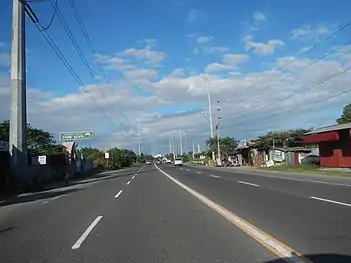 Portal towers located between steel pole 98 and lattice tower 99. Nearby is the Mexico-Hermosa transmission line.
Portal towers located between steel pole 98 and lattice tower 99. Nearby is the Mexico-Hermosa transmission line. Steel pole RHB-03 (of anchor or flag design), one of the replacement poles used in the Lahar-Affected Transmission Line relocation project, along Jose Abad Santos Avenue, Bacolor, Pampanga.
Steel pole RHB-03 (of anchor or flag design), one of the replacement poles used in the Lahar-Affected Transmission Line relocation project, along Jose Abad Santos Avenue, Bacolor, Pampanga. Steel poles 164–166 (of anchor or flag design) along Jose Abad Santos Avenue, San Fernando, Pampanga. The square asphalt marking at the middle of the road is the location where steel pole 167 was originally located before its relocation at the side of an avenue in 2010 using NAPOCOR-era steel pole 275 and also retiring pole 167 itself.
Steel poles 164–166 (of anchor or flag design) along Jose Abad Santos Avenue, San Fernando, Pampanga. The square asphalt marking at the middle of the road is the location where steel pole 167 was originally located before its relocation at the side of an avenue in 2010 using NAPOCOR-era steel pole 275 and also retiring pole 167 itself. Steel pole 167 (using NAPOCOR-era steel pole 275 and of anchor or flag design) near Dolores Flyover in San Fernando, Pampanga. Originally located at the middle of Jose Abad Santos Avenue, the said pole was relocated at the edge of the road because it posed a safety hazard.
Steel pole 167 (using NAPOCOR-era steel pole 275 and of anchor or flag design) near Dolores Flyover in San Fernando, Pampanga. Originally located at the middle of Jose Abad Santos Avenue, the said pole was relocated at the edge of the road because it posed a safety hazard.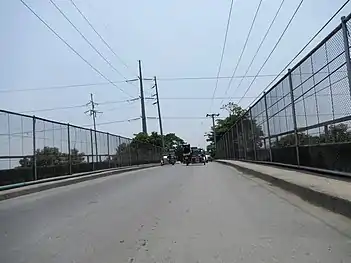 Steel pole 234 (of anchor or flag design) near Tulaoc Overpass in San Simon, Pampanga. Note that it uses NAPOCOR-era steel pole 228. The line also zig-zags which passes through residential areas on this portion instead of directly along NLEX due to the Tulaoc Overpass and to bypass the TransCo right-of-way and lands or locations for poles 233 and 234 (233 and 234 under TransCo plan of the relocation project located between NGCP-acquired and designated poles 233 and 234, and 234 and 235, respectively) as the ROWs or portions of relocated San Simon–Pulilan segment of the line that use steel poles and lands where they are located (228–254, 257–265, 268–289) were designated and acquired by NGCP thus they are owned, operated, and maintained by it.
Steel pole 234 (of anchor or flag design) near Tulaoc Overpass in San Simon, Pampanga. Note that it uses NAPOCOR-era steel pole 228. The line also zig-zags which passes through residential areas on this portion instead of directly along NLEX due to the Tulaoc Overpass and to bypass the TransCo right-of-way and lands or locations for poles 233 and 234 (233 and 234 under TransCo plan of the relocation project located between NGCP-acquired and designated poles 233 and 234, and 234 and 235, respectively) as the ROWs or portions of relocated San Simon–Pulilan segment of the line that use steel poles and lands where they are located (228–254, 257–265, 268–289) were designated and acquired by NGCP thus they are owned, operated, and maintained by it. Steel poles 235–237 (with 235 and 236 are anchor towers and have flag design while 237 is suspension tower and has triangle design), located along NLEX, are visible from MacArthur Highway in San Simon, Pampanga. Note that poles 235 and 236 use NAPOCOR-era steel poles 229 and 231 while 237 serves as replacement steel pole.
Steel poles 235–237 (with 235 and 236 are anchor towers and have flag design while 237 is suspension tower and has triangle design), located along NLEX, are visible from MacArthur Highway in San Simon, Pampanga. Note that poles 235 and 236 use NAPOCOR-era steel poles 229 and 231 while 237 serves as replacement steel pole.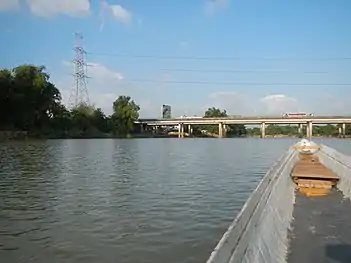 Lattice tower 255 located between Pampanga River in Apalit. It is used as one of the replacement lattice towers (along with 256) due to the relocation of the line's San Simon–Pulilan segment from 2008 to 2011.
Lattice tower 255 located between Pampanga River in Apalit. It is used as one of the replacement lattice towers (along with 256) due to the relocation of the line's San Simon–Pulilan segment from 2008 to 2011.
 Steel pole 424 near Ciudad de Victoria interchange. Originally had a triangle design from 1994 to 2019, it was changed to asymmetric due to the construction of the said interchange.
Steel pole 424 near Ciudad de Victoria interchange. Originally had a triangle design from 1994 to 2019, it was changed to asymmetric due to the construction of the said interchange.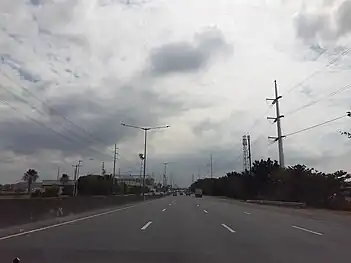 Steel poles 426–431 and original pole 127 along NLEX in Bocaue, Bulacan. Pole 426 is an anchor tower and has flag tower design while poles 427, 428, 430, and 431 are suspension towers and has triangle design. Original pole 127 and steel pole 429, however, are branch pylons and used to connect the transmission line to Meralco Duhat substation through its cut-in connection with the said substation.
Steel poles 426–431 and original pole 127 along NLEX in Bocaue, Bulacan. Pole 426 is an anchor tower and has flag tower design while poles 427, 428, 430, and 431 are suspension towers and has triangle design. Original pole 127 and steel pole 429, however, are branch pylons and used to connect the transmission line to Meralco Duhat substation through its cut-in connection with the said substation.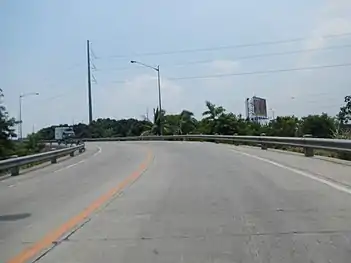 Steel pole 474 near Dulalia Overpass in Valenzuela. Originally had a triangle design from 1994 to 2007, the said pole was changed to flag design when it was replaced by newer and higher ones due to the construction of an overpass mentioned before (and also the NAPOCOR-era steel pole 474 was later used on one of the bipole towers of Mexico–Hermosa Transmission Line).
Steel pole 474 near Dulalia Overpass in Valenzuela. Originally had a triangle design from 1994 to 2007, the said pole was changed to flag design when it was replaced by newer and higher ones due to the construction of an overpass mentioned before (and also the NAPOCOR-era steel pole 474 was later used on one of the bipole towers of Mexico–Hermosa Transmission Line). Steel poles 493–495 (with 493 is suspension tower while 494 and 495 are anchor towers and all three mentioned poles have flag design) along NLEX and near Harbor Link Interchange in Valenzuela and lattice towers 497–498 (with incomplete tower designs, 497 itself is an anchor tower and 498 is a suspension tower) passing through residential areas within the said city.
Steel poles 493–495 (with 493 is suspension tower while 494 and 495 are anchor towers and all three mentioned poles have flag design) along NLEX and near Harbor Link Interchange in Valenzuela and lattice towers 497–498 (with incomplete tower designs, 497 itself is an anchor tower and 498 is a suspension tower) passing through residential areas within the said city.
Notes
- ↑ Abbreviation used on the relocated Guagua–San Fernando segment of the transmission line.
- ↑ NGCP abbreviation of the line's Hermosa–Duhat segment.
- ↑ NGCP abbreviation of the line's Duhat–Balintawak segment.
- ↑ From June 1994 to March 2011, the line's San Simon–Pulilan section ran parallel into MacArthur Highway from San Simon to Caltex in Calumpit and Pulilan Regional Road from Calumpit to Pulilan Exit in Pulilan and had a length of 15.16 km (9.42 mi). Its length was reduced to 11.69 km (7.26 mi) when it was relocated along NLEX in March 2011. The Hermosa–Balintawak Transmission Line relocation project in 2011 also reduced the amount of transmission structures on the said power line segment from 86 (228–313) to 62 (228–289).
References
- ↑ "NGCP 2014-2015 Transmission Development Plan Volume 1 (Major Network Development)" (PDF). www.doe.gov.ph. Retrieved December 2, 2020.
- ↑ "Implementation Completion Report Philippines Power Transmission and Rehabilitation Project (LOAN NO. 3626-PH)" (PDF). documents1.worldbank.org. 17 April 1998. Retrieved December 2, 2020.
- ↑ "Transco completes P 258 million project". www.philstar.com. Retrieved January 13, 2018.
- ↑ De Leon, Jovi (7 February 2018). "NGCP to start relocating transmission lines along Jasa". Retrieved 12 March 2020.
- ↑ Arcellaz, Princess Clea (1 August 2019). "NGCP starts 'relocation' of Jasa electric posts". Retrieved 18 December 2019.
- ↑ "NGCP 2012 Transmission Development Plan" (PDF). www.ngcp.ph. Retrieved August 9, 2017.
- ↑ "NGCP 2009 Transmission Development Plan" (PDF). www.doe.gov.ph. Retrieved April 18, 2018.
- ↑ "NGCP 2010 Transmission Development Plan". www.prezi.com. Retrieved April 18, 2018.
- ↑ "Operations - National Grid Corporation of the Philippines: Business Scope". ngcp.ph. Retrieved April 12, 2021.
- ↑ Arcellaz, Princess Clea (9 August 2017). "Jasa stakeholders oppose relocation of NGCP's posts". Retrieved 23 May 2020.